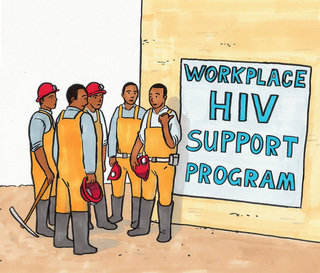Millions in need of HIV services will continue to be left out
Millions of people in need would benefit from HIV services in developing countries that are moving towards universal health coverage if these services were run more efficiently and integrated better into their health systems.
According to a study published in the Bulletin of the World Health Organization today, scaling up HIV services can achieve substantially lower unit-costs per patient, while integrating these services with other health-care services, such as for tuberculosis, can achieve better value for money than stand-alone services.
The study, by authors from the London School of Hygiene and Tropical Medicine and UNAIDS, is important because it points the way forward - not only for HIV services where US$ 19 billion was invested globally in 2012 - but for all services for chronic conditions, such as heart disease, cancer, diabetes and hypertension.
“HIV is one field where there seems to be a scientific consensus not only about what works but also about the most efficient ways to delivery health care,” said Jeremy Lauer, a health economist in the department of Health Systems Governance and Financing at the World Health Organization (WHO).
“Economic evaluation of other health programmes also shows strong evidence from an economic, programmatic and ethical perspective to support comprehensive delivery models - ones that cover the complete spectrum of prevention, detection, treatment and care,” he said.
“When you have comprehensive care for managing chronic conditions like HIV/AIDS - better prevention means less treatment, and early detection and effective treatment lead to better health outcomes for the patients,” Lauer said.
 In 2011, WHO’s Member States set themselves the goal of developing their health financing systems as a stepping stone to universal health coverage. WHO is working with countries to review, develop and implement health financing strategies that could help them to move closer towards that goal.
In 2011, WHO’s Member States set themselves the goal of developing their health financing systems as a stepping stone to universal health coverage. WHO is working with countries to review, develop and implement health financing strategies that could help them to move closer towards that goal.
In the field of HIV, progress has been made in making prevention and treatment services more widely available in low and middle-income countries. In the early 2000s, fewer than 50 000 people in sub-Saharan Africa were on antiretroviral treatment, but by the end of 2012 an estimated 9.7 million people in low and middle-income countries were receiving it.
Still, that covers only 34% of the 28.6 million people who are eligible for antiretroviral treatment, according to 2013 WHO guidelines.
The World Health Organization is currently revising its cost-effectiveness estimates for 20 diseases, risk factors and causes of injury, including in the field of HIV infection. The resulting review will serve as an evidence base for WHO guidance to countries on the path to universal health coverage.
The new study, by a team of researchers based in London and Geneva, which precedes the WHO review, analyzes 82 economic evaluation studies of HIV services in 35 low and middle-income countries.
It is the first comprehensive review of the technical efficiency and potential cost savings that can be achieved in low and middle-income countries in the six programme areas of the Joint United Nations Programme on HIV/AIDS (UNAIDS):
1. antiretroviral therapy and counselling and testing;
2. targeting at-risk populations (sex workers, men who have sex with men and people who inject drugs);
3. condom distribution and social marketing;
4. voluntary medical male circumcision;
5. programmes to prevent HIV infection in children and keep their mothers alive;
6. behaviour-change communications targeted at young adults and the general population.
For example, the authors found that the cost of treatment with antiretroviral drugs per patient and the cost of HIV prevention for key populations declines dramatically as the numbers of people reached increased.
“We found that the HIV services that reached high volumes of patients had much lower costs than those serving far fewer patients, but the likelihood of loss to follow-up - when these patient volumes are high - can be greater and is a key concern,” said co-author Anna Vassall, a senior lecturer in health economics at the London School of Hygiene and Tropical Medicine. “It’s also important that increases in efficiency, by providing services in larger facilities, do not lead to increased payments for patients trying to access those services.”
The authors found that the integration of HIV services with other services may be an important way to improve efficiency. For example, the study found that integrating tuberculosis and HIV services in low-income countries increased the impact of both programme areas, while at the same time optimizing the use of the scarce funds and clinical staff-time.
Finally, the study highlights the potential efficiency gains that can be made by improving the organization of support for the delivery of HIV services, pointing to a recent study in India, where these support costs - which are not included in service costs - can reach up to a third of the total cost of the HIV programmes themselves.
“More action and research is needed to help HIV programmes identify the best ways to improve efficiency, while at the same time ensuring that core HIV services delivered are of a high quality,” Vassall said. ..
###
The 35 countries covered by the study are: Bangladesh, Belarus, Benin, Bolivia, Botswana, Brazil, Burkina Faso, Burundi, Cameroon, Côte d’Ivoire, the Democratic Republic of the Congo, the Dominican Republic, Ecuador, Ethiopia, Ghana, Haiti, India, Indonesia, Kenya, Lesotho, Malawi, Mexico, Morocco, Nigeria, the Russian Federation, Rwanda, South Africa, Swaziland, Thailand, Uganda, Ukraine, the United Republic of Tanzania, Viet Nam, Zambia and Zimbabwe.
###
Fiona Fleck
fleckf@who.int
41-227-911-897
Bulletin of the World Health Organization